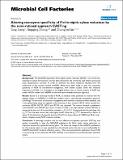| dc.contributor.author | Liang, Ling | |
| dc.contributor.author | Zhang, Jingqing | |
| dc.contributor.author | Lin, Zhanglin | |
| dc.date.accessioned | 2010-10-06T18:47:41Z | |
| dc.date.available | 2010-10-06T18:47:41Z | |
| dc.date.issued | 2007-11 | |
| dc.date.submitted | 2007-09 | |
| dc.identifier.issn | 1475-2859 | |
| dc.identifier.uri | http://hdl.handle.net/1721.1/58912 | |
| dc.description.abstract | Background: The NAD(P)H-dependent Pichia stipitis xylose reductase (PsXR) is one of the key enzymes for xylose fermentation, and has been cloned into the commonly used ethanol-producing yeast Saccharomyces cerevisiae. In order to eliminate the redox imbalance resulting from the preference of this enzyme toward NADPH, efforts have been made to alter the coenzyme specificity of PsXR by site-directed mutagenesis, with limited success. Given the industrial importance of PsXR, it is of interest to investigate further ways to create mutants of PsXR that prefers NADH rather than NADPH, by the alternative directed evolution approach. Results: Based on a homology model of PsXR, six residues were predicted to interact with the adenine ribose of NAD(P)H in PsXR and altered using a semi-rational mutagenesis approach (CASTing). Three rounds of saturation mutagenesis were carried to randomize these residues, and a microplate-based assay was applied in the screening. A best mutant 2-2C12, which carried four mutations K270S, N272P, S271G and R276F, was obtained. The mutant showed a preference toward NADH over NADPH by a factor of about 13-fold, or an improvement of about 42-fold, as measured by the ratio of the specificity constant kcat/Kmcoenzyme. Compared with the wild-type, the kcatNADH for the best mutant was only slightly lower, while the kcatNADPH decreased by a factor of about 10. Furthermore, the specific activity of 2-2C12 in the presence of NADH was 20.6 U·mg-1, which is highest among PsXR mutants reported. Conclusion: A seemingly simplistic and yet very effective mutagenesis approach, CASTing, was applied successfully to alter the NAD(P)H preference for Pichia stipitis xylose reductase, an important enzyme for xylose-fermenting yeast. The observed change in the NAD(P)H preference for this enzyme seems to have resulted from the altered active site that is more unfavorable for NADPH than NADH in terms of both Km and kcat. There are potentials for application of our PsXR in constructing a more balanced XR-XDH pathway in recombinant xylose-fermenting S. cerevisiae strains. | en_US |
| dc.description.sponsorship | National Basic Research Program of China (973 Program) (2007CB7078004) | en_US |
| dc.publisher | BioMed Central Ltd | en_US |
| dc.relation.isversionof | http://dx.doi.org/10.1186/1475-2859-6-36 | en_US |
| dc.rights | Creative Commons Attribution | en_US |
| dc.rights.uri | http://creativecommons.org/licenses/by/2.0 | en_US |
| dc.source | BioMed Central Ltd | en_US |
| dc.title | Altering coenzyme specificity of Pichia stipitis xylose reductase by the semi-rational approach CASTing | en_US |
| dc.type | Article | en_US |
| dc.identifier.citation | Microbial Cell Factories. 2007 Nov 21;6(1):36 | en_US |
| dc.contributor.department | Massachusetts Institute of Technology. Department of Chemical Engineering | en_US |
| dc.contributor.mitauthor | Zhang, Jingqing | |
| dc.relation.journal | Microbial Cell Factories | en_US |
| dc.eprint.version | Final published version | en_US |
| dc.type.uri | http://purl.org/eprint/type/JournalArticle | en_US |
| eprint.status | http://purl.org/eprint/status/PeerReviewed | en_US |
| dc.date.updated | 2010-09-03T16:18:54Z | |
| dc.language.rfc3066 | en | |
| dc.rights.holder | Liang et al.; licensee BioMed Central Ltd. | |
| dspace.orderedauthors | Liang, Ling; Zhang, Jingqing; Lin, Zhanglin | en |
| mit.license | PUBLISHER_CC | en_US |
| mit.metadata.status | Complete | |
